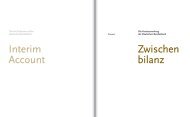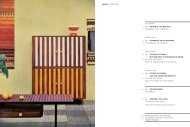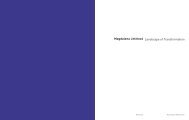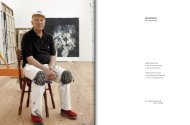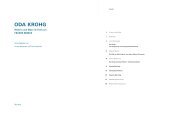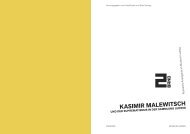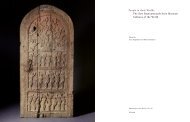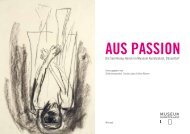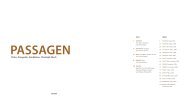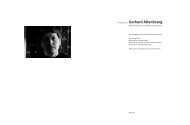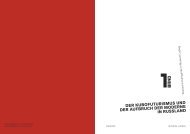Anthony Cragg dinge im kopf / Things on the mind skulpturen ...
Anthony Cragg dinge im kopf / Things on the mind skulpturen ...
Anthony Cragg dinge im kopf / Things on the mind skulpturen ...
Erfolgreiche ePaper selbst erstellen
Machen Sie aus Ihren PDF Publikationen ein blätterbares Flipbook mit unserer einzigartigen Google optimierten e-Paper Software.
I can’t pursue every opti<strong>on</strong>, so I follow just <strong>on</strong>e<br />
possibility, carry it through, and at <strong>the</strong> end<br />
of a fur<strong>the</strong>r chain of decisi<strong>on</strong>s, finally <strong>the</strong>re’s<br />
a result. Afterwards I start to c<strong>on</strong>sider what<br />
would have happened if at this or that crossroads<br />
I had taken a different directi<strong>on</strong>. somet<str<strong>on</strong>g>im</str<strong>on</strong>g>es<br />
it’s not at all clear to me what directi<strong>on</strong><br />
<strong>the</strong> work would <strong>the</strong>n have taken. These de cisi<strong>on</strong>s<br />
are often unc<strong>on</strong>scious, and just run <strong>on</strong><br />
<strong>the</strong>ir own for a few days. Then I think: »Good<br />
God, <str<strong>on</strong>g>Anth<strong>on</strong>y</str<strong>on</strong>g>, you’re a clown. If you had<br />
d<strong>on</strong>e such and such at this juncture, something<br />
quite different would have emerged.«<br />
And <strong>the</strong>n I just have to try everything out to<br />
see how <strong>the</strong> result would have differed.<br />
That’s actually a task you s<str<strong>on</strong>g>im</str<strong>on</strong>g>ply can’t fulfil.<br />
WS: What happens before you start working<br />
<strong>on</strong> a sculpture? Do you have a drawing?<br />
What <str<strong>on</strong>g>im</str<strong>on</strong>g>portance do drawings have for you?<br />
AC: When I’m drawing I experience an incredible<br />
freedom. Not all drawings have to<br />
lead to an end product. Just put pencil to paper<br />
and <strong>the</strong> journey can lead anywhere. And<br />
with relative ease compared with making a<br />
sculpture – that really isn’t easy. For sculpture<br />
you need quite a bit of infrastructure, a room,<br />
tools, material and <strong>the</strong> necessary energy.<br />
When you’re drawing you can change <strong>the</strong>mes<br />
and emoti<strong>on</strong>s from <strong>on</strong>e sec<strong>on</strong>d to <strong>the</strong> next.<br />
It’s a preparatory phase.<br />
The actual work <strong>on</strong> <strong>the</strong> sculpture starts for me<br />
by looking at <strong>the</strong> material. It is <str<strong>on</strong>g>im</str<strong>on</strong>g>portant to<br />
me that my work develops from a whole variety<br />
of decisi<strong>on</strong>s and not just from three or four<br />
schematic decisi<strong>on</strong>s. I think <strong>on</strong>e must always<br />
keep open <strong>the</strong> opti<strong>on</strong> of c<strong>on</strong>tinual alterati<strong>on</strong><br />
and variati<strong>on</strong> during <strong>the</strong> course of <strong>the</strong> work.<br />
WS: So a drawing is not <strong>the</strong> prec<strong>on</strong>diti<strong>on</strong><br />
for a sculpture? You could also make sculptures<br />
without drawings?<br />
AC: The prec<strong>on</strong>diti<strong>on</strong> for <strong>the</strong> sculpture is unambiguously<br />
<strong>the</strong> sculpture that preceded it.<br />
The drawing is certainly <str<strong>on</strong>g>im</str<strong>on</strong>g>portant for me, but<br />
it’s an activity woven into <strong>the</strong> total process.<br />
In <strong>the</strong> phase where I’m at now, my thoughts<br />
are somet<str<strong>on</strong>g>im</str<strong>on</strong>g>es too complicated for me. And I<br />
<strong>on</strong>ly get to understand <strong>the</strong>m by drawing quite<br />
a lot. I <str<strong>on</strong>g>im</str<strong>on</strong>g>agine particular sculptures, particular<br />
shapes, and after a few mental steps <strong>the</strong>y<br />
become difficult to follow. When that happens,<br />
<strong>the</strong> drawing is <strong>the</strong> <strong>on</strong>ly hope. This has<br />
been much more <strong>the</strong> case in recent years<br />
than it used to be. The necessity of <strong>the</strong> drawing<br />
for <strong>the</strong> process of my sculptural work has<br />
definitely increased.<br />
WS: You’ve been working as an artist,<br />
a sculptor, for 40 years now. How have your<br />
role and positi<strong>on</strong> changed over <strong>the</strong> years?<br />
<str<strong>on</strong>g>Anth<strong>on</strong>y</str<strong>on</strong>g> <str<strong>on</strong>g>Cragg</str<strong>on</strong>g> in C<strong>on</strong>versati<strong>on</strong> with Walter smerling<br />
m e a n d e r, 1990<br />
110 111<br />
P a s s e r s - b y , 1998<br />
Your attitude to art and your aspirati<strong>on</strong>s may not have changed, but today<br />
your œuvre has to be judged differently from 1970. Can we talk about a <str<strong>on</strong>g>Cragg</str<strong>on</strong>g><br />
traditi<strong>on</strong>, or is it still like it was <strong>on</strong> <strong>the</strong> first day, purely exper<str<strong>on</strong>g>im</str<strong>on</strong>g>ental, and tomorrow<br />
may be quite different?<br />
AC: There are always two stories to tell, a pers<strong>on</strong>al <strong>on</strong>e and an art-historical<br />
<strong>on</strong>e. When I started as a student, I needed material and looked for it everywhere.<br />
during this search, though, I also found it exciting to see where <strong>the</strong> l<str<strong>on</strong>g>im</str<strong>on</strong>g>its<br />
of <strong>the</strong> material lay and where I could still discover something new. Art-historically,<br />
of course, it’s a fact that <strong>the</strong> path of <strong>the</strong>se new materials had already been trodden<br />
by duchamp and many o<strong>the</strong>r art movements. I didn’t register that in detail,<br />
but I picked it up in <strong>the</strong> cultural atmosphere. Later, in <strong>the</strong> 1970s and 1980s, I did<br />
a lot of installati<strong>on</strong>s. For my first exhibiti<strong>on</strong> too I was c<strong>on</strong>tinually without material,<br />
but <strong>the</strong>n I found <strong>the</strong> material and <strong>the</strong>mes so that I could work in <strong>the</strong> c<strong>on</strong>text<br />
<strong>on</strong> <strong>the</strong> basis of installati<strong>on</strong>s. After a few years I ceased to find that satisfactory.<br />
Too often I stood <strong>the</strong>re with an object or some material in my hands and needed<br />
more t<str<strong>on</strong>g>im</str<strong>on</strong>g>e to do something with it, to find a form for it. That was already <strong>the</strong> case<br />
in 1981/82, a t<str<strong>on</strong>g>im</str<strong>on</strong>g>e when I was doing very many exhibiti<strong>on</strong>s with installati<strong>on</strong>s,<br />
and in c<strong>on</strong>sequence was doing a lot of travelling, which was very nice. even so<br />
I increasingly felt <strong>the</strong> need to go back to my studio, to learn new techniques, and<br />
to develop new, aut<strong>on</strong>omous forms with <strong>the</strong> material. That was for me not <strong>on</strong>ly<br />
a major change, but also a necessary step. That too is a pers<strong>on</strong>al story as well as<br />
an art-historical <strong>on</strong>e. For already in <strong>the</strong> late 1970s and early 80s it was clear



